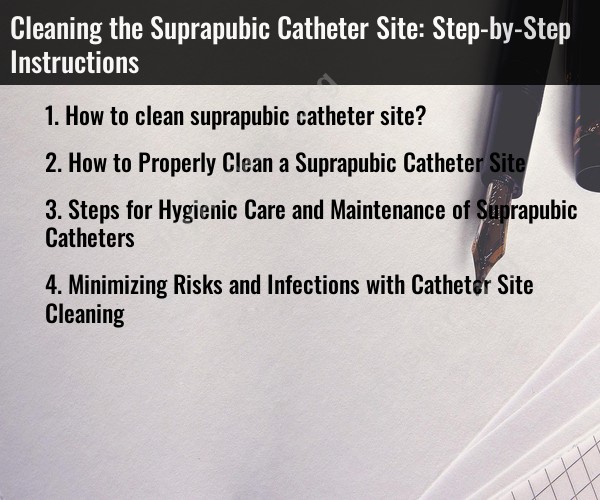How to clean suprapubic catheter site?
Cleaning the site of a suprapubic catheter is an essential part of catheter care to prevent infection and maintain proper hygiene. Here are step-by-step instructions on how to clean a suprapubic catheter site:
Before You Begin:
- Wash your hands thoroughly with soap and warm water for at least 20 seconds. Use disposable paper towels to dry your hands.
Cleaning the Suprapubic Catheter Site:
Gather your supplies: You will need clean, sterile equipment. This typically includes sterile saline solution, sterile gauze pads, and clean gloves.
Put on disposable gloves to maintain aseptic conditions.
Position the person: Ensure that the patient is comfortably positioned, either lying down or sitting. You may need to place a waterproof pad or towels under the catheter site to catch any spilled fluids.
Examine the catheter site: Carefully inspect the area around the catheter for any signs of redness, swelling, discharge, or infection. If you notice any concerning changes, inform the healthcare provider.
Open a sterile saline solution and sterile gauze pad.
Wet the sterile gauze pad with the saline solution. Make sure the gauze is damp but not dripping wet.
Gently clean the catheter site: Starting from the entry point of the catheter and moving outward, gently clean the skin around the catheter in a circular motion. Use a different section of the gauze pad for each stroke to avoid cross-contamination. Continue this process until you've thoroughly cleaned the entire site.
Dispose of the used gauze pad in a lined waste receptacle.
Inspect the catheter site again: After cleaning, check the site for any remaining debris or signs of infection. It should be clean and free from visible discharge.
Apply a clean dressing (if required): Depending on the healthcare provider's instructions, you may need to apply a sterile dressing over the catheter site. Ensure that the dressing is secure but not too tight.
Remove your gloves and dispose of them in the waste receptacle.
Wash your hands again: Thoroughly wash your hands with soap and warm water for at least 20 seconds. Use disposable paper towels to dry your hands.
Note: The frequency of catheter site cleaning and the specific products used may vary based on the healthcare provider's recommendations. Always follow the care instructions provided by the healthcare team or the patient's physician. If you notice any signs of infection, inflammation, or unusual changes at the catheter site, contact the healthcare provider for guidance.
How to Properly Clean a Suprapubic Catheter Site
To properly clean a suprapubic catheter site, you will need the following supplies:
- Clean, running water
- Mild soap
- Washcloth or gauze pads
- Sterile saline solution
- Cotton balls or Q-tips
Instructions:
- Wash your hands thoroughly with soap and water.
- Gather your supplies and place them within easy reach.
- Gently remove the old dressing.
- Clean the catheter and the surrounding skin with soap and water. Be careful not to pull on the catheter.
- Rinse the area with clean water.
- Apply sterile saline solution to the area with cotton balls or Q-tips.
- Allow the area to air dry completely.
- Apply a new dressing to the area.
Steps for Hygienic Care and Maintenance of Suprapubic Catheters
In addition to cleaning the suprapubic catheter site daily, there are other steps you can take to maintain the hygiene of your catheter and minimize the risk of infection:
- Wash your hands thoroughly with soap and water before and after handling your catheter.
- Clean your catheter regularly with soap and water.
- Avoid using harsh chemicals or lotions on your catheter or the surrounding skin.
- Empty the drainage bag regularly, when it is one-third to one-half full.
- Keep the drainage bag below the level of the bladder.
- Do not allow the drainage bag to drag on the ground.
- Observe the drainage bag for any changes in the color, odor, or amount of urine.
- Report any changes in the drainage bag or any other concerns to your doctor immediately.
Minimizing Risks and Infections with Catheter Site Cleaning
By following the steps above for cleaning your suprapubic catheter site and maintaining the hygiene of your catheter, you can minimize the risk of infection.
Here are some additional tips for minimizing the risk of infection:
- Keep the catheter site clean and dry.
- Avoid touching the catheter or the catheter site unless necessary.
- If you must touch the catheter or the catheter site, be sure to wash your hands thoroughly with soap and water before and after.
- Watch for any signs of infection, such as redness, swelling, drainage, or pain at the catheter insertion site.
- Report any signs of infection to your doctor immediately.
By following these tips, you can help to prevent infections and keep your suprapubic catheter site healthy.












